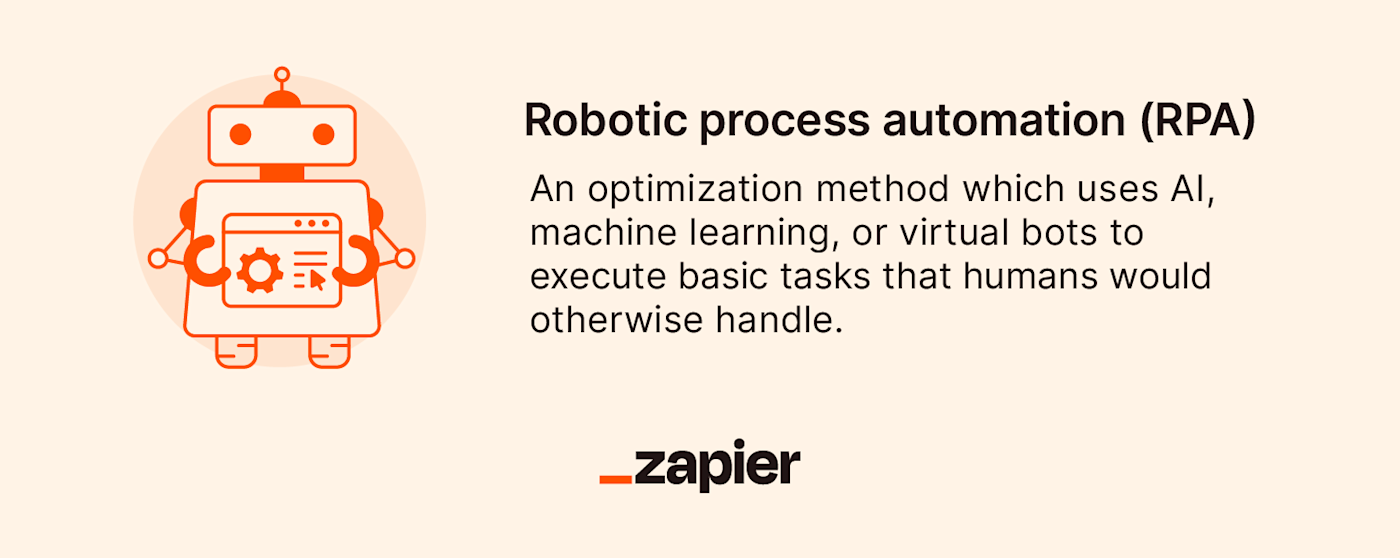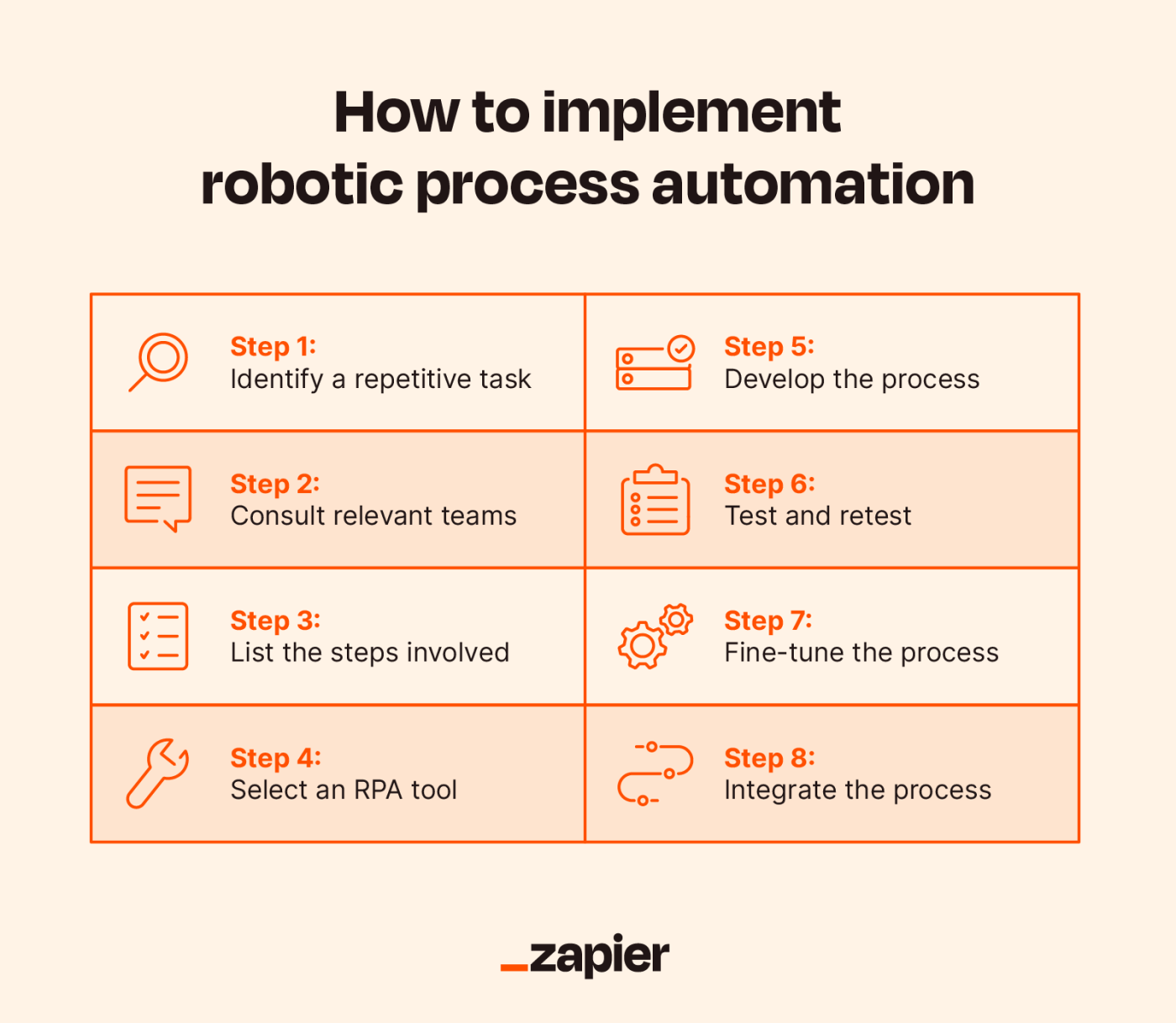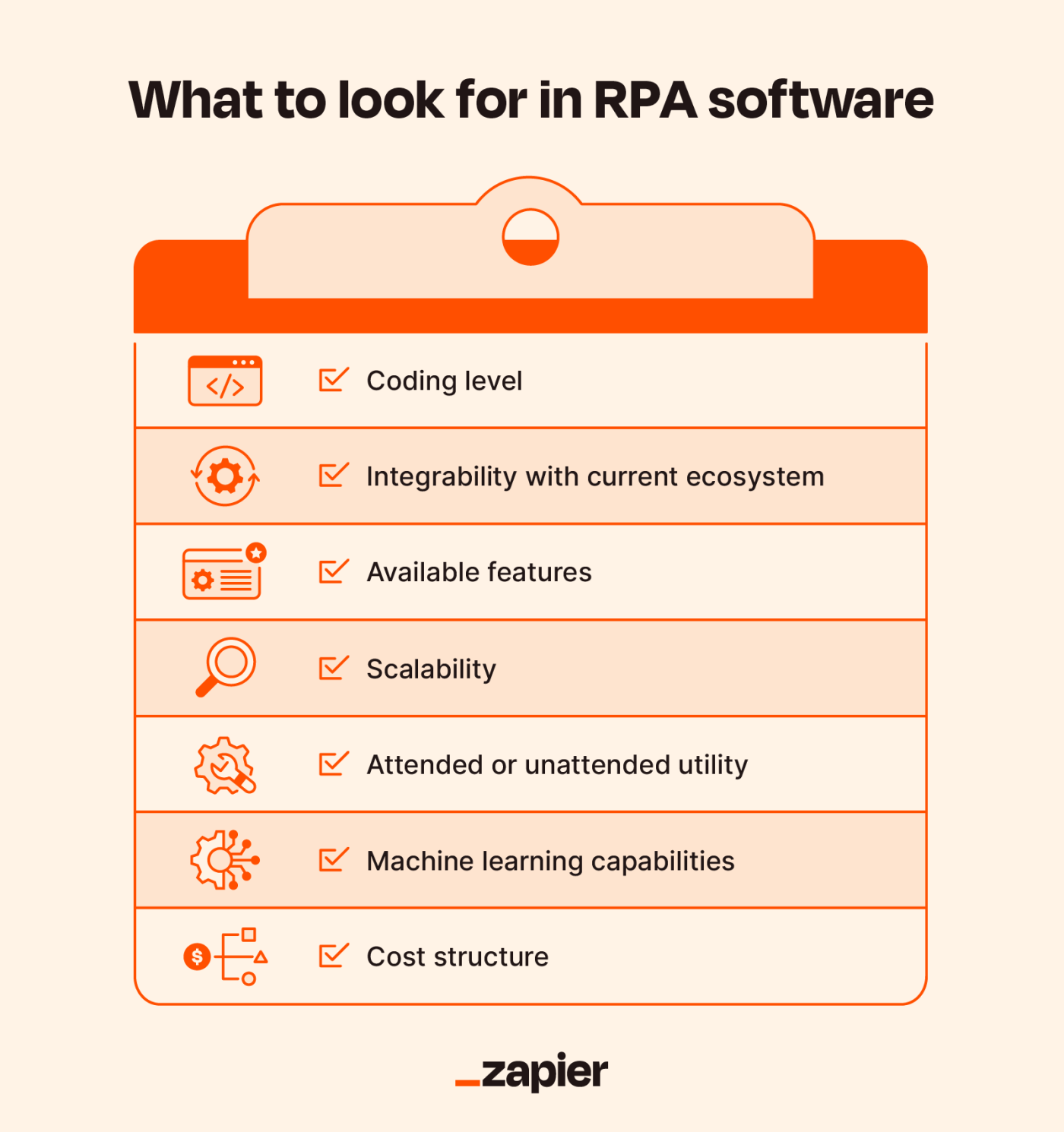Robotic automation isn't a new concept. In the 1936 movie Modern Times, Charlie Chaplin was already using it to make a commentary on post-Great Depression industrialization.
To improve productivity in the factory where Chaplin's labor is being exploited, a manager plucks him from the assembly line to test a robotic feeding machine. They strap Chaplin to a rotating table that automatically crams a bowl of soup, bites of bread, and a rotating ear of corn in his face. As anyone who's ever seen a Charlie Chaplin movie could predict, the machine malfunctions and slams a pie in his face, then repeatedly batters him with a sponge designed to clean his very tiny mustache.
Today, robotic process automation is conceptually more or less the same as Chaplin's vision—just with (usually) less pie.
Table of contents:
What is robotic process automation (RPA)?
Robotic process automation (RPA) is an optimization method that uses AI, machine learning, or virtual bots to execute basic tasks that humans would otherwise handle. RPA helps businesses and organizations streamline their processes by allowing people to hand off repetitive or menial tasks to software, freeing them to spend more time on higher-value tasks. It's becoming more and more popular as part of the digital transformation of the workplace.

RPA vs. AI
Artificial intelligence (AI) is an essential part of robotic process automation. AI has many applications beyond RPA, but in the context of RPA, it allows users to deploy virtual solutions that mimic human actions and even interactions on behalf of a human.
RPA vs. workflow automation
You can use RPA in workflow automation, but workflow automation doesn't necessarily have to include RPA. No-code software can automate more general workflow processes like lead management by connecting apps to execute sequences of actions based on triggers. For example, you could set up a trigger that funnels contact information from a Google Form straight to a Mailchimp list—no RPA required. Since these automated processes don't include more nuanced "robotic" processes like AI or machine learning, they wouldn't put the R in RPA.
Learn more about workflow automation in Zapier's quick-start guide.
Benefits of robotic process automation
Bringing robotic process automation to your organization can do a whole lot more for you than comically symbolize the shortcomings and humanitarian dangers of industrialization, as it did for Charlie Chaplin. It can also lead to:
Reduced overhead: Cut down on labor and implementation expenses by using one piece of software to bring robotic automation to multiple processes.
Increased efficiency: Taking hours of repetitive work off your team's plate will help them get through essential tasks more effectively.
Greater scalability: Since it's highly iterative and rooted in scalable software, robotic automation can grow with you.
Fewer human errors: Automation does the same task the same way every time according to the rules you set, virtually eliminating human errors.
Improved employee happiness: Many employees enjoy being freed from the kinds of tedious tasks that robotic automation is designed to handle.
More fluid customer experience: Since automated processes are performed the same way every time, customers get timely, predictable responses.
Better compliance: Stay compliant by automating reporting or sending automatic notifications to relevant team members.
How you can use RPA: 6 examples
Need ideas for how to use robotic process automation for your business or organization? Here are six hypothetical examples that showcase the potential of automating high-volume repetitive tasks.
Example 1: Customer support
As an eCommerce company continues to grow, so does the number of customer support requests they get. They deploy a chatbot to supplement their current small team. The chatbot is programmed to answer common queries and direct customers to relevant articles and forum pages. This allows their team members to spend more time focusing on complex queries and upselling.
Example 2: Applications
A mortgage company uses RPA to handle applications. The automation software pre-screens applications using AI, follows up to address missing fields, and responds to complete applications using email templates. When approved applicants want to move forward, their information gets assigned to individual brokers to follow up in person.
Example 3: Data collection
RPA helps a market research firm scrape online content for data and trends. The software pulls data from thousands of websites and social media pages, downloads it to an internal server, and automatically analyzes data for custom reporting.
Example 4: Compliance
Using RPA, a large healthcare organization automates monitoring and risk assessment to maintain compliance. Their bots monitor employee reporting logs and automatically identify potential compliance issues by vetting them against pre-established compliant processes. The bots notify relevant employees with times, missing actions, and potentially non-compliant entries.
Example 5: Billing
A growing SaaS company uses RPA to automate and optimize their billing process. Using RPA technology, they can automatically notify users about upcoming payments, lock accounts with missed payments, and even suggest trials of package upgrades. The software compiles billing information into reports and identifies revenue trends.
Example 6: Outreach
A marketing company integrates OpenAI with Trello and Mailchimp to create email templates. Every time there's a need for a new template (like a distinctive qualified lead type), the marketing manager adds instructions to Trello as a new board, prompting GPT to automatically create a template. Those templates are automatically loaded into Mailchimp, and when new leads are added to a corresponding list, they're automatically sent the appropriate email.
How to implement RPA
Implementing RPA isn't as simple as setting up common software solutions like basic email automation. You may want to look into RPA certification courses or hiring a certified professional if you don't have developers with RPA training.
Once you have your IT team in order, take these steps to launch your RPA solution.
Step 1. Identify a repetitive task: The key to unlocking RPA is applying it to a task that's performed often and requires a low level of skill, creativity, attention, or problem solving.
Step 2. Consult relevant teams: To get the most out of robotic automation, get input from every team and every team member related to that process. Note any friction points or suggestions from those who perform the relevant tasks, hand the process off, or receive the process from another team member.
Step 3. List the steps involved: Using team member input, list out every step involved in executing the process. Include actions that trigger the process and actions triggered by completing it.
Step 4. Select an RPA tool: As with any software, RPA tools come in a wide variety of packages with unique strengths and weaknesses. Check with your IT team to find one that can meet your unique automation needs.
Step 5. Develop the process: Coordinate development with your internal IT team or external RPA professional to put the automation sequence into action.
Step 6. Test and retest: Once the process is in place, have your teams test it by simulating the process from start to finish. Have multiple people try it as if they were the end-user.
Sep 7. Fine-tune the process: Once you have input from multiple people giving front-end and back-end perspectives, incorporate their notes to make necessary tweaks to improve the process.
Step 8. Integrate the process: When your team is satisfied with the automation process and it's gone through enough testing to show consistent results, put it into action and start looking for another opportunity for RPA.

What to look for in RPA software
RPA products can be complex to deploy, and undoing them can be even more complex if you decide to switch to another one. Test features and consult with your teams to make sure you pick one that both meets their needs and fits into your existing ecosystem.
Coding level: Some options require more complex coding than others, which could be a pro or a con, depending on your needs and dev capabilities.
Integrability with current ecosystem: Consider how the product's features and requirements will fit into your current software ecosystem, including whether it's compatible with the various file types and unstructured data you rely on.
Available features: Are you looking to transfer data across apps, scrape website data, deploy chatbots, integrate email automation, or all the above? Make sure your chosen product has the features you're looking for.
Scalability: As your business continues to grow, your RPA solution should keep up. Consider what features you may need in the future and be as sure as you can be that your product is equipped to meet your long-term goals.
Attended or unattended utility: Do you need software that runs only when you need to deploy it, or would you get more out of software that responds automatically to set triggers?
Machine learning capabilities: If your automation needs require machine learning models to do things like analyze unstructured data or reach hyperautomation status, explore this feature in-depth.
Cost structure: Pricing models can vary as widely as the products themselves. Some may charge by user, others have flat per-bot fees, some charge for licensing, and some may have a combination of all the above.

Robotic process automation FAQs
What is robotic process automation?
Robotic process automation (RPA) is a productivity tactic that uses AI or machine learning to handle repetitive and/or low-level tasks for human workers. RPA can free up time and reduce frustration by automatically completing basic processes so people can dedicate time to higher-level tasks.
What is a robotic process automation example?
A common example of robotic process automation is using an RPA product to automatically migrate or transfer data from sources like webforms, emails, or other documents. Through AI, the product selectively scrapes only relevant data, writes relevant code, and then populates a table with the data. Without RPA, a human would have to sift through then copy/paste or drag and drop this data manually.
Why is it called robotic process automation?
Robotic process automation gets its name from using programmed bots to automate basic task sequences. These aren't physical machine robots—these are virtual solutions for handling tasks otherwise performed using computers.
What are the challenges of RPA?
RPA can be a challenge to implement due to:
Added complexity: There's no question that RPA is more complex than many other productivity solutions, and you may need new hires or more training to implement it effectively.
Ongoing IT needs: Once you start RPA, you'll need to make sure your IT team is equipped to maintain it for the long haul.
Impacts on internal structure: RPA will take some tasks away from some roles while freeing other roles for new responsibilities, potentially leading to organizational restructuring.
Impacts on internal culture: Since RPA can affect role responsibilities and comes with a learning curve for those who use it, it can bring a shift in attitudes and working relationships.
Automate more processes with Zapier
If you want to start with workflow automation, Zapier can make the process as clean as Charlie Chaplin's robotically dabbed mustache. Integrate your most critical apps, and start automating the repetitive tasks that keep you from doing the work you really value.
Here are more ways you can take advantage of process automation:
How automation changes your responsibilities to make more time for mindful work
while True: learn(): Understand machine learning by playing a game
Zapier is the leader in workflow automation—integrating with 6,000+ apps from partners like Google, Salesforce, and Microsoft. Use interfaces, data tables, and logic to build secure, automated systems for your business-critical workflows across your organization's technology stack. Learn more.






